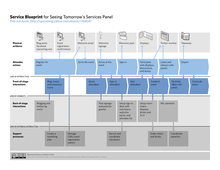Service blueprint

A Service Blueprint for the organization of a Conference
The service blueprint is a technique used for service innovation, but has also found applications in diagnosing problems with operational efficiency and can be used to conceptualise structural change (i.e. repositioning). The technique was first described by Lynn Shostack, a bank executive, in the Harvard Business Review in 1984.[1] The blueprint shows processes within the company, divided into different components which are separated by lines.
Contents
The service blueprint defines:
- Customer Actions: The steps that customers take as part of the service delivery process.
- Frontstage (Visible Contact Employee) Actions: This element is separated from the customer actions by a ‘line of interaction’. These actions are face-to-face actions between employees and customers.
- Backstage (Invisible Contact Employee) Actions: The ‘line of visibility’ separates the onstage from the Backstage actions. Everything that appears above the line of visibility can be seen by the customers, while everything under the line of visibility is invisible for the customers. A very good example of an action in this element, is a telephone call; this is an action between an employee and a customer, but they don’t see each other.
- Support Processes: The ‘internal line of interaction’ separates the contact employees from the support processes. These are all the activities carried out by individuals and units within the company who are not contact employees. These activities need to happen in order for the service to be delivered.
- Physical Evidence: For each customer action, and every moment of truth, the physical evidence that customers come in contact with is described at the very top of the service blueprint. These are all the tangibles that customers are exposed to that can influence their quality perceptions.
Building a blueprint
The process of structuring a blueprint involves six steps:[2]
- The identification of the service process, that is supposed to be blueprinted
- The identification of the customer segment or the customers that are supposed to experience the service
- Picturing the service from the customer’s perspective
- Picturing the actions of the contact employee (onstage and backstage), and/or technology actions
- Linking the contact activities to the needed support functions
- Adding the evidence of service for every customer action step
Traditionally, service blueprints have been depicted with lines and text boxes to depict anything from user actions to support processes.
References
- ↑ Shostack, G. Lynn. "Designing Services that Deliver", Harvard Business Review, vol. 62, no. 1 January - February 1984, pp. 133–139
- ↑ Wilson Alan/ Zeithaml, Valerie A./ Bitner, Mary Jo/ Gremler, Dwayne D. (2008): Services Marketing: Integrating Customers Focus Across the Firm, Glasgow, 2008. (p. 203-206)
- Service Blueprinting: A Practical Technique for Service Innovation, by MJ Bitner, AL Ostrom, FN Morgan
- A Key to Service Innovation: Services Blueprinting
This article is issued from Wikipedia - version of the 11/29/2016. The text is available under the Creative Commons Attribution/Share Alike but additional terms may apply for the media files.